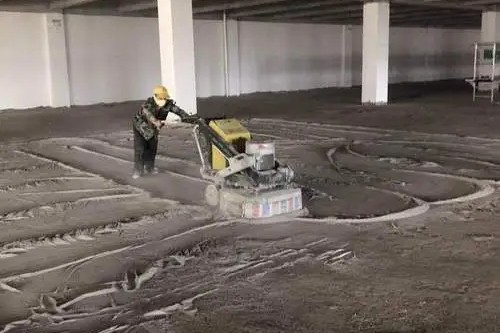The function of floor grinder
Introduction of Floor Grinder
A floor grinder is a specialized piece of equipment designed to resurface and restore floors to their original condition. It's a versatile tool capable of tackling a wide range of floor issues, from removing stubborn stains and aged coatings to smoothing rough surfaces and preparing floors for new finishes.
By utilizing abrasive materials mounted on rotating discs, floor grinders effectively grind away imperfections, leaving behind a clean, even surface ready for further treatment. This process is essential in various applications, including commercial, industrial, and residential floor restoration projects.

Floor Grinder Function: Improve the quality and durability of your floors
A floor grinder does more than just surface preparation; it is a versatile and indispensable tool that plays a vital role in the construction, decoration and maintenance of all types of flooring. From smoothing and grinding to polishing, floor grinders are used to enhance the appearance, durability and functionality of concrete, stone, marble, granite and other flooring materials. Let’s take a closer look at the multi-faceted capabilities of a floor grinder and its impact on floor finishing and maintenance.
1. Smoothing, grinding and polishing
The main function of a floor grinder is to smooth, grind and polish floors, transforming rough and uneven surfaces into smooth, polished surfaces. Whether you are sanding indoor or outdoor floors, refinishing old floors, sanding and leveling concrete floors, or polishing stone, floor sanders are the equipment of choice for achieving a perfect finish. Ensure flooring is not only visually appealing but also safe and functional by effectively addressing surface imperfections.
2. Troubleshooting grounding problems
Over time, floors can accumulate a variety of problems, such as loose dust, stains, and unevenness, which can reduce their appearance and usability. Floor grinders excel at solving these problems by grinding and polishing floors to remove stains and loose dust, resulting in a cleaner, more beautiful surface. In addition, it can effectively solve the problem of uneven floors, ensuring that the floor is not only beautiful but also safe and practical.
3. Smoother, flatter surface
In construction and decoration projects, achieving a smooth, even surface is crucial to the overall quality of the floor. Floor grinders play a key role in this process, allowing workers to adjust floor conditions and address uneven surfaces. By carefully processing the floor, the grinder ensures that the surface is not only smoother but also flatter, meeting the highest quality and safety standards.
4. Increase floor hardness
In addition to addressing surface imperfections, floor grinders also help improve the hardness of your flooring. By sanding and scoring, the floor's pressure resistance is effectively increased, thereby extending its service life. The increased hardness not only improves the floor's durability but also reduces the need for frequent maintenance, making it a cost-effective and sustainable solution for floor finishing and maintenance.
How a Floor Grinder Works?
A floor grinder is a powerful tool that utilizes mechanical force to resurface and refine floors. Its core components include a motor, a reducer, and grinding discs.
The grinding process:
The heart of the floor grinder lies in its motor, which powers the rotation of the grinding discs. The reducer, acting as a gear system, adjusts the speed and torque of the discs to match the specific grinding requirements.
When the grinder is activated, the rotating grinding discs come into contact with the floor surface. The friction generated between the discs and the floor gradually removes material, leveling irregularities, and smoothing the surface. Water is often used during the grinding process to control dust and heat, enhancing the overall efficiency and quality of the finish.
Operating a floor grinder
Operating a floor grinder is relatively straightforward. The process typically involves:
1. Choosing the right equipment: Selecting appropriate grinding discs based on the floor type and desired outcome.
2. Power connection: Connecting the grinder to a reliable power source.
3. Grinding process: Moving the grinder across the floor in a controlled manner, allowing the grinding discs to remove material.
4. Water application: Applying water to the grinding surface to manage dust and heat.
5. Cleaning: Thoroughly cleaning the grinder and the work area after completion.
The Feasibility And Actual Effect Of Floor Grinders In Grinding Floor Tiles
Floor grinders are powerful tools designed primarily for concrete and stone surfaces. While they can be used on tile, it's essential to proceed with caution and understanding.
The challenges of grinding tile:
Tile Hardness: While some tiles are relatively soft, others are exceptionally hard. Using an inappropriate grinder or grinding disc can damage the tile.
Glaze Removal: Most tiles have a protective glaze. Grinding can remove this, affecting the tile's appearance and durability.
Tile Thickness: Removing too much material can compromise the tile's structural integrity.
Potential benefits of tile grinding:
Removing Surface Stains: For certain types of stains that penetrate the tile surface, grinding can be effective.
Leveling Minor Irregularities: If tiles have slight height differences, careful grinding might help create a more even surface.
Preparing for Re-glazing: In some cases, grinding might be a preparatory step for re-glazing tiles.
Cautions and recommendations:
Test in an Inconspicuous Area: Before proceeding with a full-scale project, test the grinder on a small, hidden area to assess its impact on the tile.
Use Low-Pressure Water: Keep the tile cool during the grinding process to prevent cracking.
Consider Alternatives: In many cases, replacing damaged tiles or using tile restoration products might be more effective and less risky.
-
Online service
-
Official wechat account

-
QQ:40933769
-
E-mail:sales@z-lion.com
Online Message
Please feel free to give your inquiry in the form below. We will reply you in 24 hours.

